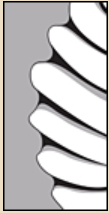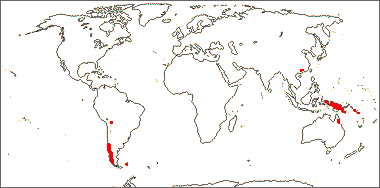Family name: Corsiaceae Beccari
Synonym(s): Achratinitaceae F. A. Barkley, nom. nud.
Common name(s): corsia family
*Number of genera/species: 3/27
List of genera records in GRIN-Global
seed
Fruit a loculicidalloculicidal:
type of capsular dehiscence, opening longitudinally through the locules (compare septicidal)
 capsulecapsule:
capsulecapsule:
a dry, dehiscent fruit derived from a compound ovary dehiscing to the base (Corsia) or at terminal aperture (Arachnitis), 20–35 mm long, linearlinear:
dehiscing to the base (Corsia) or at terminal aperture (Arachnitis), 20–35 mm long, linearlinear:
(shape) long, narrow, and uniform in width; (of embryo) embryo is straight and much longer than wide to oblongoblong:
to oblongoblong:
2D shape—much longer than broad with nearly parallel sides, corners are rounded , tereteterete:
, tereteterete:
approximately circular in cross section; width and thickness approximately equal
 or triangulartriangular:
or triangulartriangular:
2D shape—three relatively straight sides with distinct corners; more angular than teardrop-shaped in transection, with many seeds. Pericarppericarp:
in transection, with many seeds. Pericarppericarp:
fruit wall or fruit coat
purple, brown, dulldull:
reflecting only a low proportion of incident light, with no apparent sheen , glabrousglabrous:
, glabrousglabrous:
without hairs
.
Seeds fusiformfusiform:
spindle-shaped; broadest at the middle and tapering at both ends , tereteterete:
, tereteterete:
approximately circular in cross section; width and thickness approximately equal
 in transection, 0.6–3 mm long (minute in Arachnitis), with seed coat elongated into apicalapical:
in transection, 0.6–3 mm long (minute in Arachnitis), with seed coat elongated into apicalapical:
at or pertaining to the end of the seed or fruit distal from its point of attachment (i.e., base)
and basalbasal:
at or pertaining to the point of attachment; (of embryo) embryo occupies one end of the seed
wings. Funiculus long, exceeding margins of fruit, or short, not persistent in the fruit. Seed coat reddish brown to black, obscurely longitudinally groovedgrooved:
surface relief—linear depressions that may be single or form a series of grooves over the surface or reticulatereticulate:
or reticulatereticulate:
surface relief—netted, raised walls or concave grooves forming a net-like surface pattern with flat, concave, or convex interspaces with punctatepunctate:
with punctatepunctate:
surface relief—dotted with pits or with translucent, sunken glands or with colored dots, similar to pitted hilumhilum:
hilumhilum:
on seeds, the scar indicating where the funiculus was attached; on grass caryopses, the scar visible on the outer fruit surface revealing where the seed is attached on the inner fruit wall surface; or in Asteraceae cypselae, the scar visible on the outer fruit wall revealing where the fruit was attached to the receptacle .
.
Embryo minute, undifferentiated from food reserves, acotyledonous.
Endosperm present.
| Fruit | |
| Type | loculicidalloculicidal: type of capsular dehiscence, opening longitudinally through the locules (compare septicidal)  capsulecapsule: capsulecapsule:a dry, dehiscent fruit derived from a compound ovary  |
| Size range | 20–35 mm long |
| Shape(s) | linearlinear: (shape) long, narrow, and uniform in width; (of embryo) embryo is straight and much longer than wide  , oblongoblong: , oblongoblong:2D shape—much longer than broad with nearly parallel sides, corners are rounded  |
| Color(s) | purple, brown |
| Seed | |
| Size range | 0.6–3 mm long |
| Shape(s) | fusiformfusiform: spindle-shaped; broadest at the middle and tapering at both ends  |
| Surface relief | reticulatereticulate: surface relief—netted, raised walls or concave grooves forming a net-like surface pattern with flat, concave, or convex interspaces  , groovedgrooved: , groovedgrooved:surface relief—linear depressions that may be single or form a series of grooves over the surface  |
| Color(s) | reddish brown, black |
| Unique features | Bicaudate seeds, numerous, very small, and seed coats usually reticulatereticulate: surface relief—netted, raised walls or concave grooves forming a net-like surface pattern with flat, concave, or convex interspaces  . . |
| Other | |
| Embryo | minute, undifferentiated from food reserves, acotyledonous |
| Nutritive tissue | endosperm multicellular (Corsia); reduced to few cells (Arachnitis) |
Western South America to Falkland Islands, China, Australasia.

Distribution map courtesy of Angiosperm Phylogeny Website.
Baskin and Baskin 2021Baskin and Baskin 2021:
Baskin C and Baskin J. 2021. Relationship of the lateral embryo (in grasses) to other monocot embryos: A status up-grade. Seed Science Research 31 (3): 199-210. doi:10.1017/S0960258521000209; Dahlgren et al. 1985Dahlgren et al. 1985:
Dahlgren RMT, Clifford HT, and Yeo PF. 1985. The families of the monocotyledons: structure, evolution, and taxonomy. Springer-Verlag, Berlin. 520 pp.; Flora of Australia 2021+Flora of Australia 2021+:
Flora of Australia. Australian Biological Resources Study, Canberra. Accessed January 2021–March 2024. URL: http://www.ausflora.org.au; Kirkbride et al. 2006Kirkbride et al. 2006:
Kirkbride JH, Jr, Gunn CR, and Dallwitz MJ. 2006. Family guide for fruits and seeds, vers. 1.0. Accessed September 2020-January 2022. URL: https://nt.ars-grin.gov/seedsfruits/keys/frsdfam/index.cfm .; Kubitzki et al. 1990+Kubitzki et al. 1990+:
Kubitzki K et al., eds. 1990+. The families and genera of vascular plants. 7+ vols. Berlin etc.; Stevenson and Loconte 1995Stevenson and Loconte 1995:
Stevenson DW and Loconte H. 1995. A cladistic analysis of monocot families. In: Rudall PJ, Cribb PJ, Cutler DF, and Humphries CJ, eds. Monocotyledons: Systematics and Evolution. Royal Botanic Gardens, Kew.; Takhtajan 2009Takhtajan 2009:
Takhtajan A. 2009. Flowering plants: Second edition. Springer Nature, Switzerland. 871 pp.; Watson and Dallwitz 1992+Watson and Dallwitz 1992+:
Watson L and Dallwitz MJ. 1992+. The families of flowering plants: descriptions, illustrations, identification, and information retrieval. Version: 6th Accessed September 2020-September 2022. URL: delta-intkey.com
*The number of genera and species is based on Christenhusz and Byng 2016Christenhusz and Byng 2016:
Christenhusz MJM and Byng JW. 2016. The number of known plant species in the world and its annual increase. Phytotaxa 261 (3): 201-217. https://doi.org/10.11646/phytotaxa.261.3.1, which may differ from the number of genera in GRIN-Global.